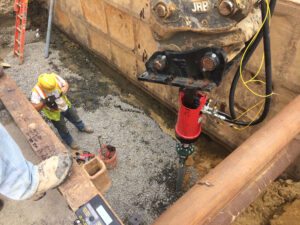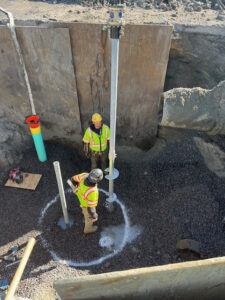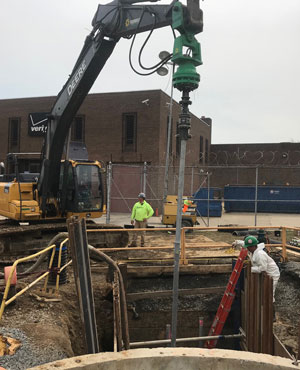Helical piers and anchors are widely used for specific applications in both the private and public sectors and site conditions usually dictate their selection. Some or all of the “usual suspects” are at play and neutralized by the decision to go helical, including access, vibration, ease of mobilization/demobilization, and minimizing disturbance to neighbors. How those construction−mitigating issues play out vary in different situations or market sectors. It’s worth a closer look at the manner in which helical technology is uniquely qualified to overcome the site challenges involved in sewer projects.
 Our documented history in this arena goes back to 2007 when 603 Grouted Helical Micropiles were installed to support sewer lines in the limited access, narrow streets of certain neighborhoods of Queens in New York City. All of the usual site issues steered the New York City Department of Design and Construction to use helicals, but a separate concern about varying soil conditions from neighborhood to neighborhood resulted in the use of the grouted pile. A Grouted Helical pulls a grout column down around the helical extensions, creating a greater section modulus, isolates the steel from corrosive elements, and eliminates buckling concerns.
Our documented history in this arena goes back to 2007 when 603 Grouted Helical Micropiles were installed to support sewer lines in the limited access, narrow streets of certain neighborhoods of Queens in New York City. All of the usual site issues steered the New York City Department of Design and Construction to use helicals, but a separate concern about varying soil conditions from neighborhood to neighborhood resulted in the use of the grouted pile. A Grouted Helical pulls a grout column down around the helical extensions, creating a greater section modulus, isolates the steel from corrosive elements, and eliminates buckling concerns.
Click here to read the Case History for Meadowmere Sewer Reconstruction.
On Opal Street in Philadelphia, PA, tight access (narrow streets), ease of mobilization/demobilization, and no vibration all translated into a more neighborhood-friendly experience for the denizens of Opal Street, which is why the Philadelphia Water Department chose helicals for this project. Crowded urban neighborhoods with narrow streets and older structures cry out for the use of helicals.
Click here to read the Case History for the Opal Street Sewer Reconstruction.
Harbor Town was a rare instance when many of the normal motivations to use helicals were not at play except for weak soil conditions requiring a deep foundation. It was a new construction site with good access, so larger equipment could be used to speed up the installation process and at a much lower cost than the mobilization for driven piles. An IDEAL 1.75” square shaft with an 8” grout column was specified in this instance.
Click here to read the Case History for Harbor Town.
 Three more recent sewer jobs followed the script for the use of helicals. Old Orchard Beach in Maine and Ocean City, NJ are both seaside resort towns with suspect, varying soil conditions where deep foundations are widely specified. Helicals, which respond to torque values to ascertain depth, assure minimum embedment requirements across a changing soil environment.
Three more recent sewer jobs followed the script for the use of helicals. Old Orchard Beach in Maine and Ocean City, NJ are both seaside resort towns with suspect, varying soil conditions where deep foundations are widely specified. Helicals, which respond to torque values to ascertain depth, assure minimum embedment requirements across a changing soil environment.
Click here to read the Case History of Old Orchard Beach Sewer Project.
Click here to read the Case History for Ocean City NJ Sewer Project.
Interestingly, Island Park in Hempstead on Long Island, NY had more consistent soil conditions, but still required a deep foundation through a heavy traffic area where minimal disruption to travelers and residents needed to be maintained.
Click here to read Case History for Island Park Flood Mitigation Project.
Public utilities, including water and sewer Authorities, in addition to private facilities of all stripes, have been using helicals for many years at their facilities for a variety of applications. In these applications, it is the minimal disturbance to operations with easy mobilizations/demobilizations, small-low-impact equipment, access mitigation, and no vibration that carry the day.
Click here to read Case Histories of Sewer Projects.
Click here to read Case History for Poplar Point Sewer Project.
As all these Case Studies indicate, helicals are IDEALly suited to utility work, including water and sewer, and it’s a wonder, in many instances, how other competing piling systems get specified!




